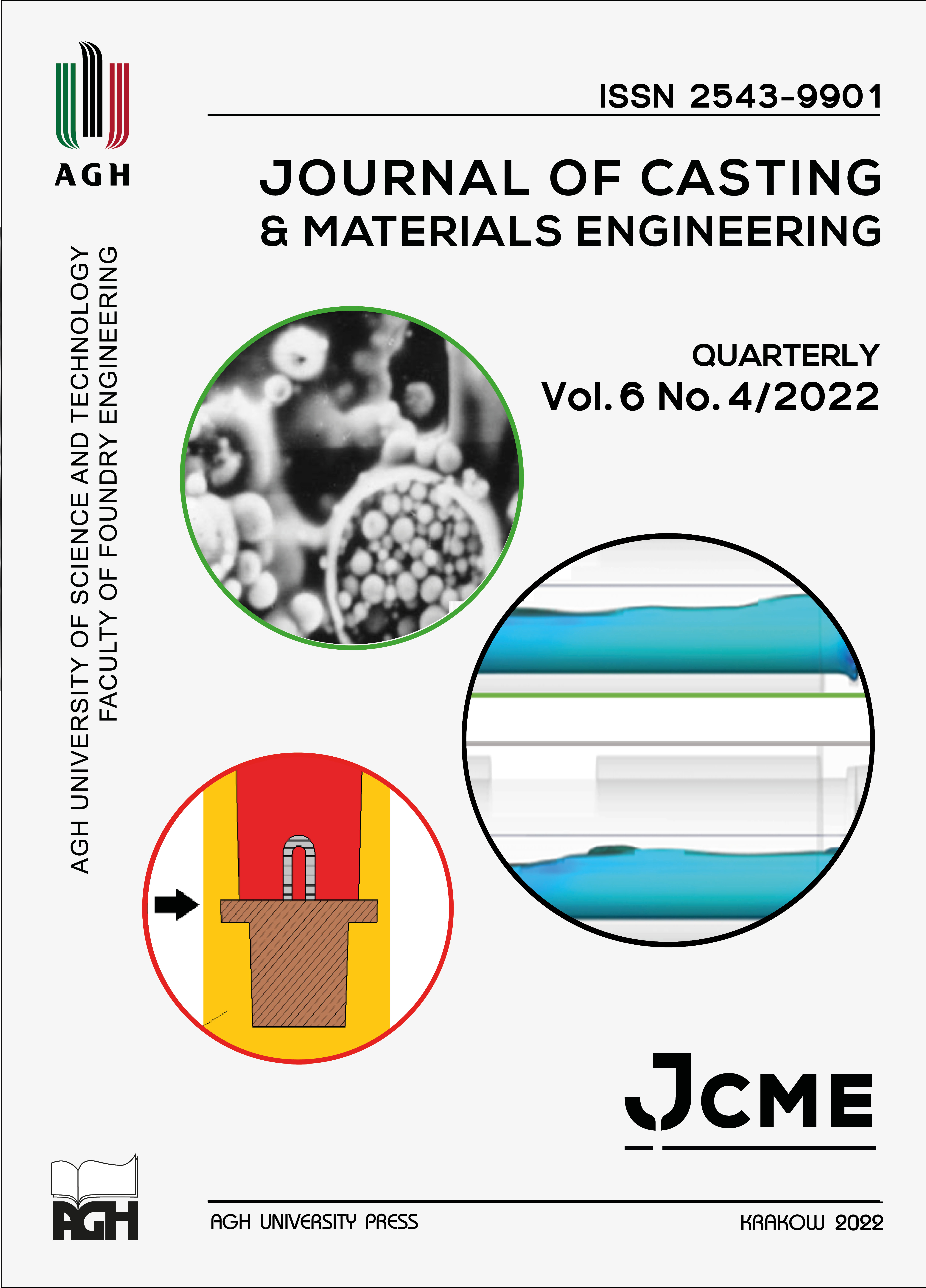The Optimization of a Numerical Steel Foundry Simulation Through a Characterization of the Thermal Properties of the Materials
DOI:
https://doi.org/10.7494/jcme.2022.6.4.76Abstract
In many foundries, numerical simulation is used to determine the origins of different defects as this tool allows the acceleration of the design process. However, the databases provided by different software do not seem to tally with the actual properties of the material. In fact, every foundry uses a different grade of steel and varying mixtures of sand. An evaluation of the impact of different material properties showed the importance of measuring every physical property to improve the database of the software. Following this, an experiment was conducted to evaluate the gap between numerical simulations and the results obtained through experimentation. This experiment, called thermal analysis, consists in measuring the solidification and cooling of a cylinder filled with liquid steel. After the calculation of the steel properties and a simulation with real experimental parameters, a comparison between each cooling curve was realized. This comparison shows that the calculated properties provide a simulated cooling curve which is closer to the experimental curve than the properties in the original database. We did not explore all of the metal properties in this study, but the modification of the sand properties was explored, together with the thermal conductivity of the steel and sand. These other measurements will be obtained in a future study.
Downloads
References
Chvorinov N. (1940). Theorie Der Erstarrung Von Gußstücken. Gießerei, 27, 177–188.
Wlodawer R. (1966). Directional Solidification of Steel Castings. London: Pergamon Press.
Popielarski P. (2020). The Conditions for Application of Foundry Simulation Codes to Predict Casting Quality. Terotechnology XI. Materials Research Proceedings, 17, 23–30. Doi: https://doi.org/10.21741/9781644901038-4.
Rappaz M. (2020). Does MCWASP Still Follow Moore’s Law? Forty Years of Advances in Microstructure Modeling. IOP Conference Series: Materials Science and Engineering, Vol. 861. Doi: https://doi.org/10.1088/1757-899x/861/1/012001.
Bernat Ł. & Popielarski P. (2020). Identification of Substitute Thermophysical Properties of Gypsum Mould. Archives of Foundry Engineering, 20(1), 5–8. Doi: https://doi.org/10.24425/Afe.2020.131274.
Tiberto D. & Klotz U.E. (2012). Computer Simulation Applied to Jewellery Casting: Challenges, Results and Future Possibilities. Materials Science and Engineering, 33. Doi: https://doi.org/10.1088/1757-899x/33/1/012008.
Mills K.C. & Lee. P.D. (2001). Thermophysical Property Requirements for Modelling of High Temperature Processes. Proceedings: First International Symposium on Microgravity Research and Applications in Physical Sciences and Biotechnology, 10–15 September 2000, Sorrento, Italy, SP-454 , 555–564.
Kavicka F. & Stetina J. (2000). The Influence of Thermophysical Properties of Steels on the Numerical Simulation of a Concasting Process. In: Brebbia C.A. & Power H. (Eds.), Boundary Elements XXII, 243–252.
Prikhod’ko O.G., Deev V.B., Prusov E.S. & Kutsenko A.I. (2020). Influence of Thermophysical Characteristics of Alloy and Mold Material on Casting Solidification Rate. Steel in Translation, 50, 296–302. Doi: https://doi.org/10.3103/S0967091220050095.
Svildró J., Diószegi A. & Svidró J.T. (2020). The Origin of Thermal Expansion Differences in Various Size Fractions of Silica Sand. International Journal of Cast Metals Research. Doi: https://doi.org/10.1080/13640461.2020.1838078.
Kowalski J. (2010). Thermal Aspects of Temperature Transformations in Silica Sand. Archives of Foundry Engineering, 10(3), 111–114.
Ignaszak Z. & Popielarski P. (2015). Effective Modeling of Phenomena in Over-Moisture Zone Existing in Porous Sand Mould using the Simplified Simulation Systems Applied in Foundry. Defect and Diffusion Forum, 365, 200–206. Doi: https://doi.org/10.4028/www.scientific.net/ddf.365.200.
Ignaszak Z. & Popielarski P. (2016). Identification of the Moisture Distribution in the Intensively Heated Porous Sand Mould. Defect and Diffusion Forum, 367, 121–129. Doi: https://doi.org/10.4028/www.scientific.net/ddf.367.121.
Kaufman L. & Nesor H. (1978). Coupled Phase Diagrams and Thermochemical Data for Transition Metal Binary Systems – I. Calphad, 2(1), 55–80. Doi: https://doi.org/10.1016/0364-5916-(78)90005-6 .
Dantzig J.A. & Rappaz M. (2016). Solidification, 2nd Edition, Lausanne: EPFL Press.
Hecht M. (1986). L’analyse thermique en fonderie de fonte. Centre Technique des Industries de la Fonderie. Edition Techniques Des Industries De La Fonderie, Paris.
Djurdevic M.B. (2021). Application of Thermal Analysis in Ferrous and Non Ferrous Foundries. Metallurgical and Materials Engineering, 27(4), 457–471. Doi: https://doi.org/10.30544/673.
Abouchadi H. (2002). Mise au point de tests expérimentaux pour validation thermomécanique du procédé de moulage des aciers. PhD Thesis. Ecole Nationale D’arts Et Métiers, Paris.
Downloads
Published
Issue
Section
License
Copyright (c) 2022 Morgan Souêtre, Alexis Vaucheret, Philippe Jacquet, Jean-François Carton

This work is licensed under a Creative Commons Attribution 4.0 International License.
How to Cite
Accepted 2022-11-10
Published 2022-12-22


